Get inspired by the mega-successful Master Breeder Marc Comtois and his son Steve as they present this inside look at Comestar with their move to DeLaval robots. Thanks to the Semex Alliance and DeLaval for presenting this great session.
Archive for March 2021
No, we are not talking about the Colombian singer and songwriter who has sold over 80 million records which have made her the best-selling female Latin artist of all time. We are talking about Erbacres Snapple Shakira the EX-95 2020 Breeder’s Choice Grand Champion. Her story is not a rag to riches story. It is a story of some of the most talented breeders from around the world coming together to breed and develop an international superstar.
SHAKIRA’S DREAMLIKE RISE WAS PROPELLED BY VISION and DEFINED ROLES
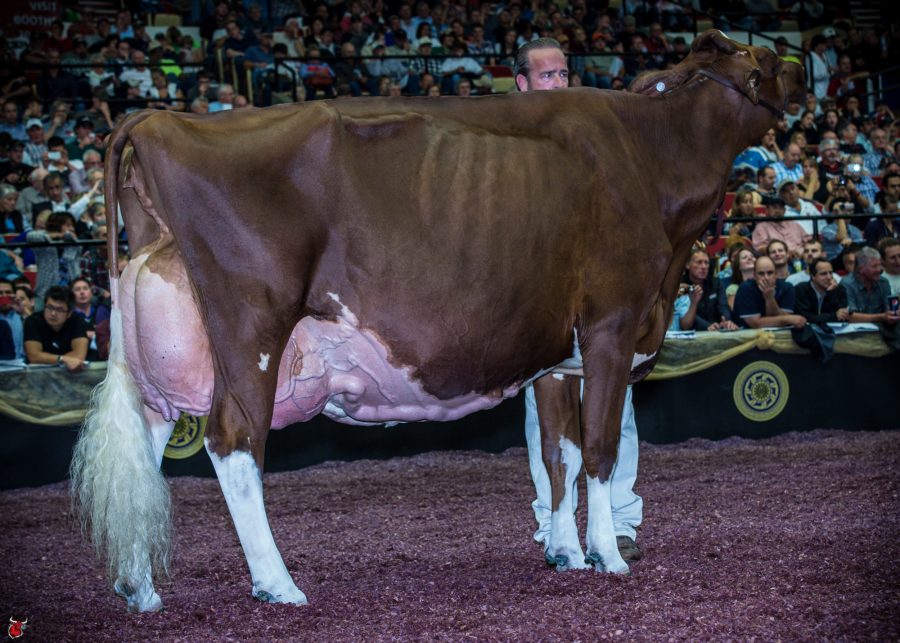
KHW Regiment Apple-Red-ET
Excellent-96 4E DOM 28*
4-01 2x 365d 35,750 4.7 1682 3.7 1314
9-01 2x 365d 36,750 4.3 1582 3.3 1211
Lifetime: 240,640 4.7 11394 3.6
Her accomplishments could fill a book, but a few of the highlights include:
• Grand Champion International Red & White Show 2011
• Unanimous All-American Junior Two-Year-Old 2006
• All-American Red & White 125,000 lb. Cow 2013
• All-American Red & White Aged Cow 2011
• World Champion Red & White Cow 2010 & 2014
• Reserve Grand Champion International Red & White Show 2013
• Reserve Grand Champion Royal Winter Fair Red & White Show 2009
• Premier Breeder International Red & White Show 2017 & 2019
We begin our story with a very passionate breeder who came to America with a passion and a dream. Francisco Rodriguez came to USA for work but wanted to live out a dream and so he set out to find partners to make that happen. (Read more: FRANCISCO RODGRIGUEZ: Passion with a Purpose). Dairy dreams often start with star breeding the best to the best. For Shakira that starts with her dam, Snapple-Red. Snapple is from the great Apple-Red (Read more: KHW Regiment Apple-Red-Et – Everything and more and KHW Regiment Apple-Red – Beauty, performance, and even more record accomplishments). For Francisco the pedigree was what dreams are made of. So, when John Erbsen came to him about Snapple, who at the time was 6 months of age, there was no question that he wanted to own her. However, having just moved to the US and being heavily invested in flushing the Apple-1, a clone of Apple, that he had purchased earlier, financing was limited. He also needed to get access to pedigree potential genetics and to build a team. It was this outstanding pedigree combination that had the passionate team interested. Nevertheless, passion does not pay bills so, for Francisco, partners were needed. His search did not take long. He already had worked with John with Apple-2 and knew the great care and knowledge that he brought to the table. He also had a long history of working with fellow Colombian, Juan Pablo Muriel and knew of his interest in partnering and the business acumen he brought with him. With that the team was formed that would possess the vital skills needed to produce an international superstar. They purchased Snapple at 6 months of age.
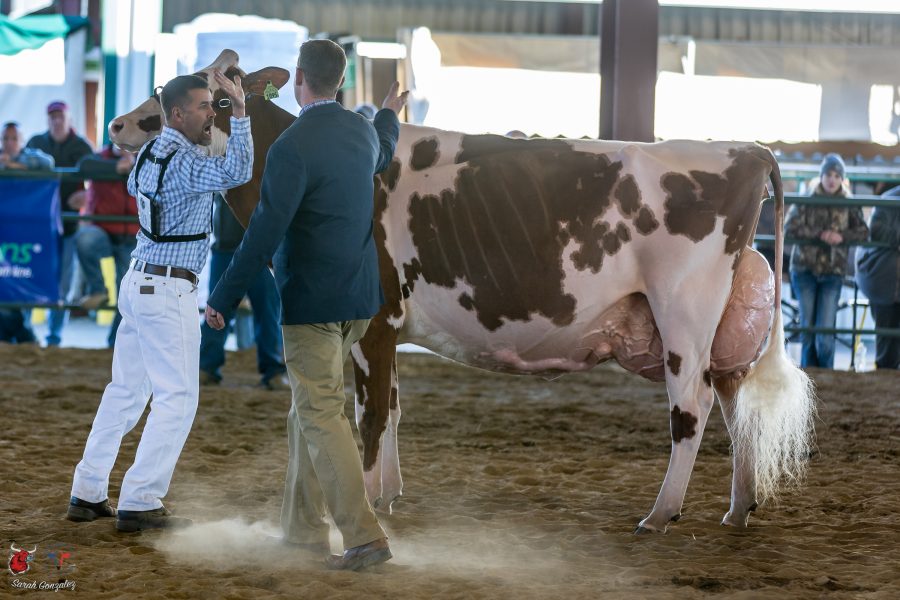
MISS APPLE SNAPPLE-RED-ET (REDBURST) Grand Champion- North American Open Red & White Show 2020 MILKSOURCE, WI
Under the outstanding care of John Erbsen, Snapple continued to develop. After flushing her twice, he says, “We exported embryos to Central America and Germany. One of Snapple-Red’s mates was O’Kaliber.” O’Kaliber is the son of the famous European show cow Decrausaz Iron O’Kalibra and KHW Elm-Park Acme, a half-brother to Apple. The next star, ET Shakira, would be born before Snapple-Red calved as a 2-year-old.
Snapple would go on to be Grand Champion, Midwest National Red & White Spring Show, 2019, Unanimous All-American R&W Four-Year-Old, 2017 and Reserve All-Canadian R&W Senior Cow, 2019. Snapple was shown in heifer form by Junior Holstein Member, Connor Erbsen, and, since World Dairy Expo 2017, has been owned by Milksource Genetics.
ERBACRES SNAPPLE SHAKIRA – “IT’S ALL IN THE NAME”
When naming calves there are many decisions to be made. Francisco points out that since John had done such great work caring for and developing Snapple and now Shakira it was only natural to use John’s Erbacres prefix. When it came her name, all team members worked together and Francisco suggested the name Shakira, and the partners all agreed. “I always wanted a cow with the name of the famous Colombian singer so, as soon as she was born, that was it” The story continues from the personal heart of Francisco. “I have always been a party guy. I told my wife Sofia that when our Shakira wins, we will dance like crazy.” To make the dream even more outstanding, Francisco has announced, “When our Shakira wins, they will play “Hips Don’t Lie.” Her story was now ready to be set to Shakira’s music!
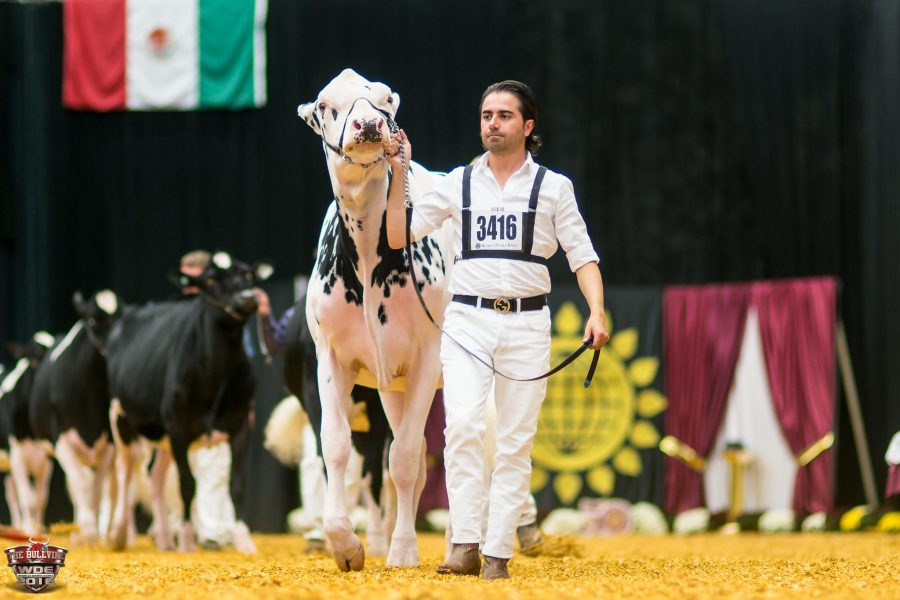
Francisco leading Shakira as a yearling at the 2016 World Dairy Expo
SHAKIRA’S PATH TO STARDOM
Shakira was a nice calf and loved by all her owners but, as they reported, “She was not a show winner at the start.” Francisco explains “Shakira had great parts but John’s raising program was for growth and health and not skinny show heifers so, in the heifer classes in the show ring, she often carried too much weight.” At that time, Shakira ended up in the middle of the heifer classes.
BEAUTY IS IN THE TRAINED EYE OF THE BEHOLDER
John Erbsen also saw her special beauty. “My kind are the ones that get better every year. They develop out and calve back.” With Shakira, he sums it up, “I could see that Shakira was going to do that.” John says his judgement was confirmed by others. “It gave me confidence, when other people could also see her potential. My sister Paula, after seeing Shakira when she was four or five weeks fresh said, ‘This one is going to be pretty special!’”
Shakira’s breeders knew there was potential but only after a couple of months fresh in her first lactation did it all start coming together. John Erbsen saw her every day and he reports that “Shakira was not the same as she started out after calving.” He colorfully adds, “On the phone, I teased Francisco that she might not be great. However, by the time Francisco visited and saw her, he was in love. She had changed a lot. She was coming on. She was going to be pretty special.” We now see exactly how special. Shakira has excelled at significantly improving her conformation after first calving.
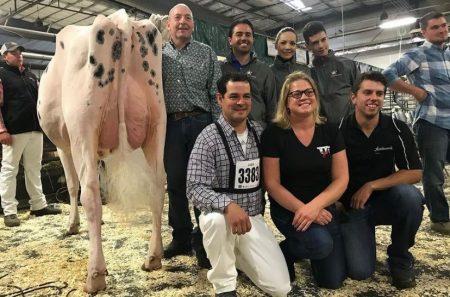 ”SHAKIRA STOOD OUT FROM THE REST FROM THE BEGINNING”
”SHAKIRA STOOD OUT FROM THE REST FROM THE BEGINNING”
The team then decided to take her to the mecca, World Dairy Expo. Where she started to get lots of attention. Ysabel Jacobs continues the story, “When Yan walked the aisles at World Dairy Expo in 2017, he came back to our string and said, “I saw the best cow.” Thus, began discussions over price and purchasing. This inspired further activity. “We took her on a walk.” reports Ysabel, with the following details. “There was careful consideration and growing excitement until, on show morning, when I went into the barn, before 5 a.m. Yan said, “We bought her!” Shakira was now owned by the new partnership of Ferme Jacobs, Jacob’s family members and other extended family. (Read more: Ferme Jacobs – “Dreams without goals are just….dreams”)
SHAKIRA IS PART OF A FOREVER FAMILY
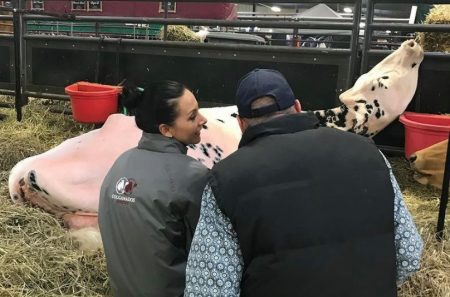
Sofia and John saying their good byes to Shakira.
One would understand, if those who owned Shakira never wanted to part with her. The growing worldwide support might also confirm that position. However, John Erbsen is quick to point out, “I don’t run a museum here.” He does admit though that his whole family was attached to Shakira as were Francisco and his wife, Sofia. Everyone agreed that Shakira was a great personality animal. “We all wanted to be able to see her continue her journey.” Everyone supported the final decision. “Our partnership was confident we were selling her to a home, where she could keep developing.” Juan Pablo also recognized that not selling would leave them with “too much money on four legs.” Even as Francisco confirmed that “We sold her to another great Team.”, it was still emotional. John and Sofia, and probably other family as well, shed tears. In a beautiful picturing of the connection that is maintained with this well-loved rising star, Rodriguez declares, “The original team celebrates every time Shakira rings another bell.”
SHAKIRA’S GOT TALENT
It isn’t surprising that those who have worked with Shakira have many positive anecdotes about her. Ysabel says, “It is a pleasure to work with Shakira. She responds well to feed and environment.” It should be noted that Shakira’s environment changed between owners. Ysabel explains, “Shakira was used to being by herself all the time at Erbacres. She had also been a 4-H calf. When she arrived at Ferme Jacobs, we let her be by herself but within a pen with the group.” Ferme Jacobs has carefully developed this style of housing show animals. “Show cows will be more aggressive and learn more by being part of a group.” Ysabel and Yan have witnessed how this works. “When feed is presented, they learn to run. If they don’t hurry, others are going to eat it.” This housing style is also mirrored in Shakira’s present situation, according to Ysabel. “She is currently with the fresh cows. She herself hasn’t calved but she is due in June and adds, “Shakira is doing really well right now.” To those who reach for the stars, these are the ordinary details of an extraordinary cow.
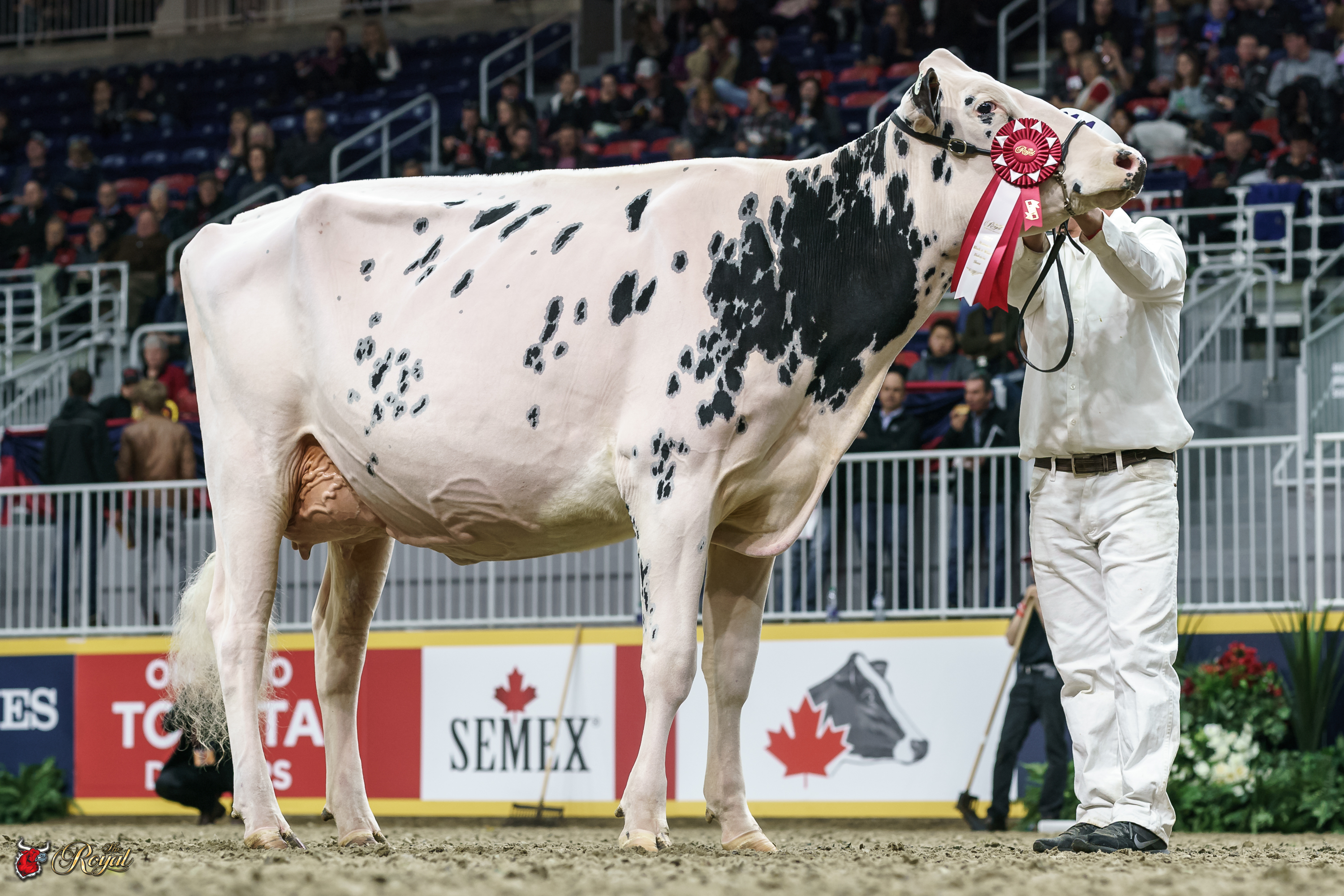
ERBACRES SNAPPLE SHAKIRA 1st place Junior Two Year Old 2017 Canadian National Holstein Show Antelimark, Jacobs, Theraulaz, TY-D
Ysabel Jacobs also has notes along this line. “Shakira has continued to change quite a bit. She wasn’t the big, framed cow that she is now.” Specifically, she clarifies. “Shakira always had the perfect rump and especially good udder, as a heifer.” Some had noted that she had somewhat of a thick as a heifer “Her dam had a thick head and a thick neck as a heifer. Shakira’s front end has cleaned up a lot Ysabel sums up. “Shakira has a long dairy neck now.”
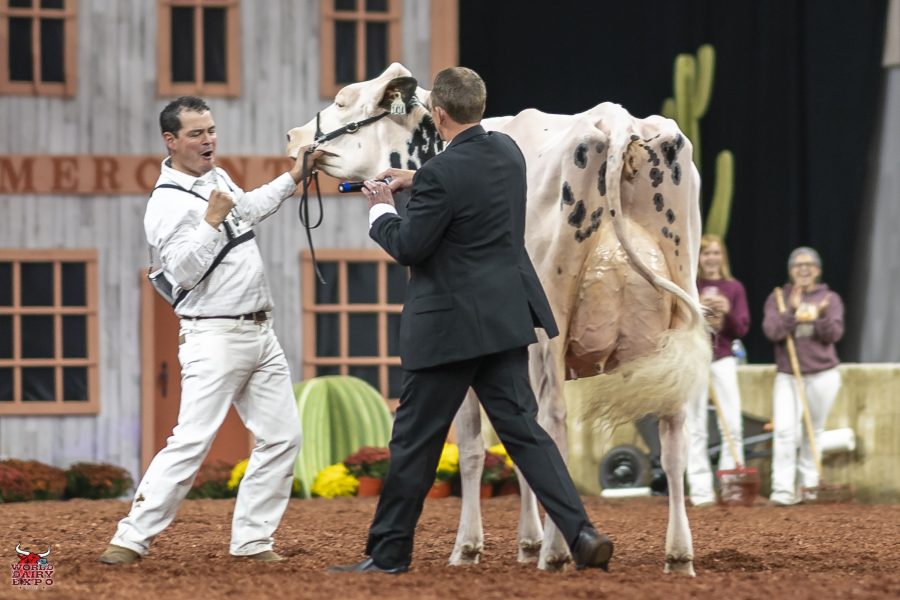
Erbacres Snapple Shakira-ET VG89, gets the nod for Intermediate Champion at World Dairy Expo. She is jointly owned by Ferme Jacobs, Ty-D Holsteins, Killian Tehraulaz, Ferme Antelimarck and C & F Jacobs. She is led by Tyler Doiron.
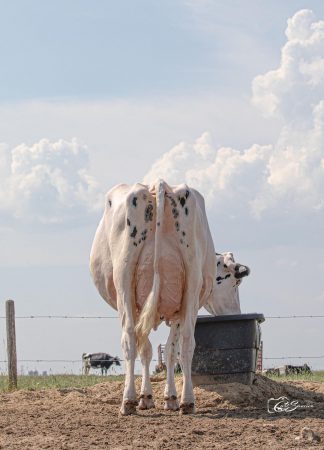 “SHAKIRA’S STAR TREK”
“SHAKIRA’S STAR TREK”
As we tell Shakira’s story, we cannot help but be impressed with the ways she is winning new fans. A notable measure of her growing popularity is that for Shakira it connects three continents – South America, North America and Europe – and continues to grow.
Regardless of the business you are in, awareness is powerful. Even with the instant communication that is growing exponentially, that alone doesn’t guarantee success. However, in six years, Shakira’s popularity has skyrocketed. Her popularity has multiplied partly because of passion and partly because of marketing. “Being able to actually see her on line has a double impact.” says Francisco. “Nothing beats being able to see her mobility” That is fantastic marketing. Francisco then enthuses that it is possible now for many more eyes to see Shakira’s great characteristics.
Ysabel also praises what online marketing can provide. “Everyone can actually see so much volume with that perfect udder.” In show cow circles, many claim perfect udders but Ysabel says, “You can have a good udder but, with Shakira, you have both the quality and the exceptional veining.” This opportunity for visual sharing, brings her story to the eyes and hearts of dairy breeders everywhere. Shakira’s story is able to go where no dairy star story has gone before.

Erbacres Snapple Shakira
Grand Champion
2020 Summer Invitational
Ferme Jacobs, Antelimarck, Theraulaz and TY-D
HOW TO REACH FOR THE STARS
For dairy breeders who would be thrilled to emulate Shakira’s success, there is much to learn. It starts with Francisco’s first two steps “Make your passion a dream by having a sound genetic plan and goals. Stick to your plan.” He then adds another key requirement. “Dairy breeding is a great business, but it is more than just cows.” With impassioned emphasis, Francisco told The Bullvine, “People make the difference. You must have a great team.” Fortunately for Shakira, great teams contributed to her development at each stage of her progress. A long-range view is the starting point. Persistence through challenges will teach lessons. Always have patience. Teamwork triumphs.
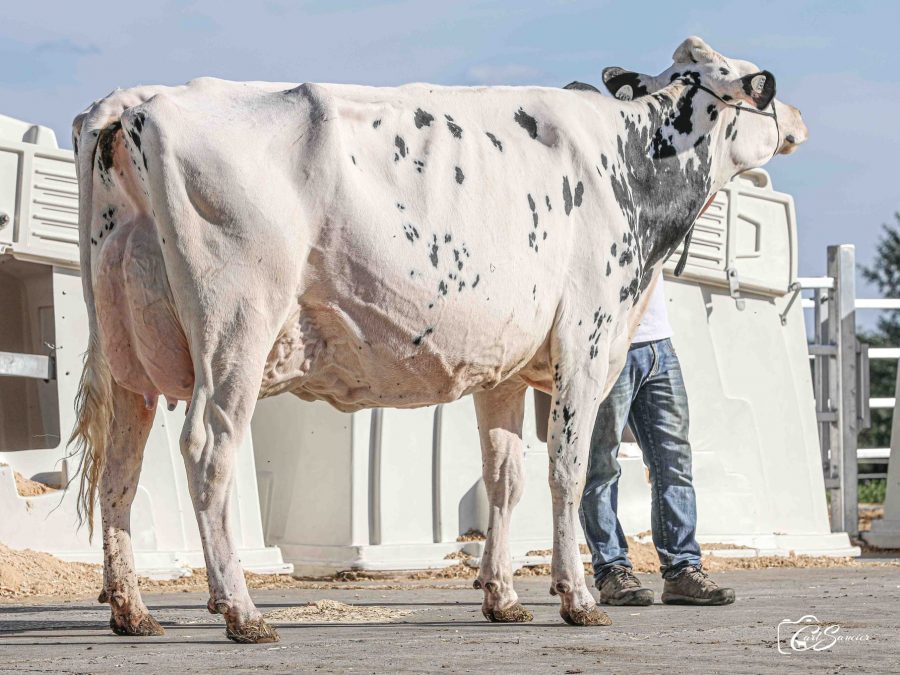
“SHARING THE SPOTLIGHT WITH SHAKIRA”
The dream began with a star’s name. Francisco had a dream that one day his namesake would emulate that star’s success, while standing in the ultimate dairy spotlight. There have been many star performances for SHAKIRA on the way. Her success has won her an audience and many loyal followers. It is likely that SHAKIRA will indeed stand in the ultimate spotlight one day at World Dairy Expo and the Royal Winter Fair, but Francisco’s dream doesn’t stop there. In his story of Shakira, he dreams that she won’t be alone. Her namesake SHAKIRA will be there too and the song playing in the background will be, “HIPS DON’T LIE!” Another first. Another starburst.
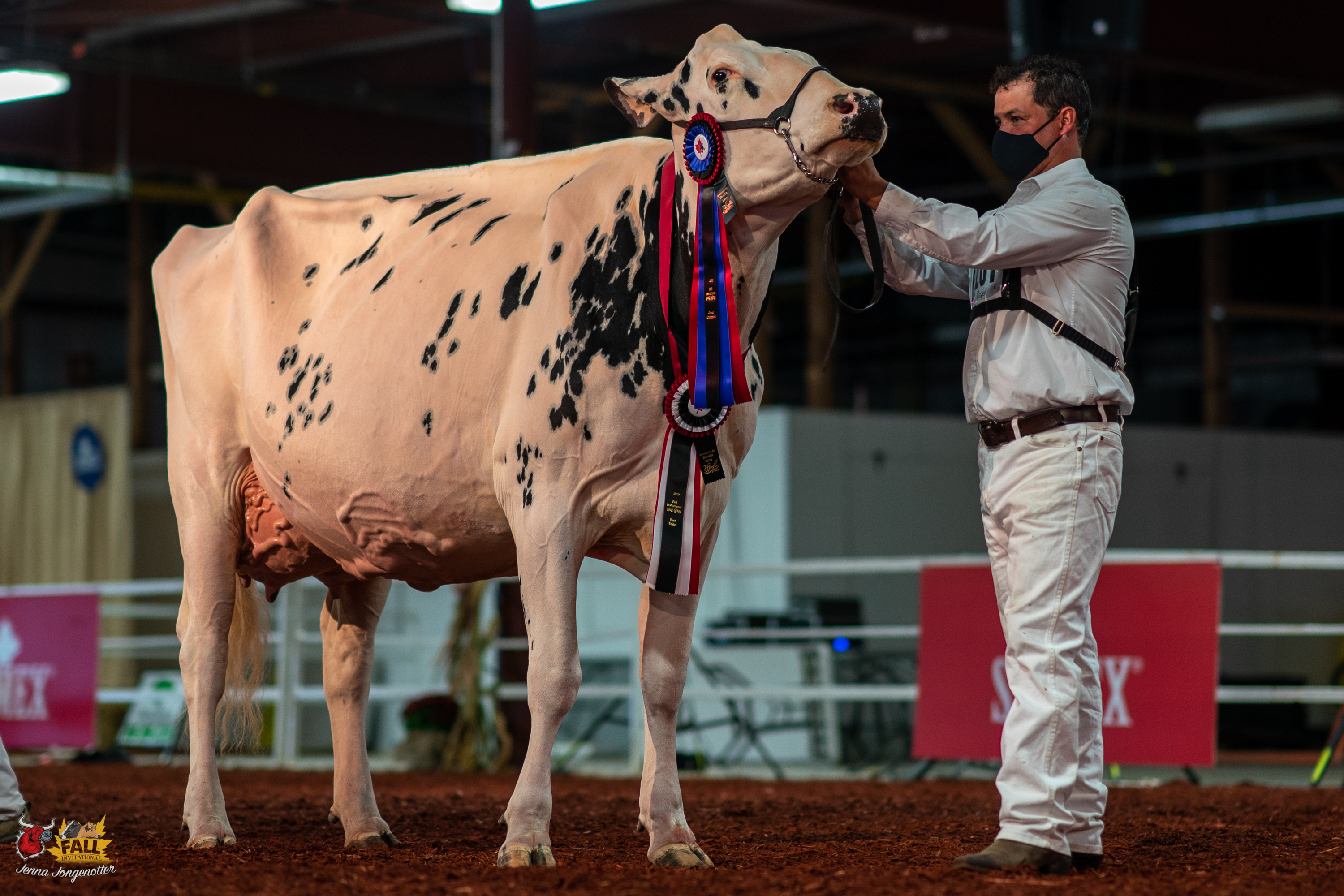
ERBACRES SNAPPLE SHAKIRA Grand Champion – Fall Invitational Holstein Show C & F JACOBS, FERME ANTELIMARCK 2001 INC, FERME JACOBS INC, KILIAN THERAULAZ, TY-D HOLSTEINS, CAP-SANTÉ, QC
SHAKIRA’S FUTURE INCLUDES EVEN MORE STAR SHINE
With so many facts already recorded in the historically exceptional story of Shakira, the question becomes, “Where will Shakira go from here?” Each person who has known her best answers from a different perspective, but they all share the same confidence, “Whatever happens next, Shakira, will continue to set new records and leave outstanding genetics.” Today The Bullvine and fans throughout the dairy world heartily applaud Grand Champion Breeder’s Choice Winner – Shakira.

Get original “Bullvine” content sent straight to your email inbox for free.
Going forward dairy farms will be more automated, larger and more business and systems (field to consumer) based. On the animal side dairy cattle breeding will be focused on productivity, efficiency, health, reproduction, welfare and the milk consumer will demand. An informative document looking to dairying in the future is the USDA-Economic Research Service July 2020 Report (#274) – Consolidation in U.S. Dairy Farming. It is recommended reading for all dairy farmers. It accurately reports many past changes and predicts future changes in dairy farming.
No Time to Waste in Planning Breeding
Breeding decision in 2021 will result in female calves bring born in 2021-2022. By 2025 those calves will be the major part of milking herds. There is no time to waste in deciding on the elite sires that will produce the cows dairy farmers will need in 2025 and beyond.
Where have Past Total Merit Indexes (TMI’s) Landed Dairy Breeders?
TMI’s came on the dairy cattle breeding scene over thirty years ago for the purpose encourage breeding for more than a single trait – yield or conformation.
Fast forward to today and we see promotion, buying and using focused on one number – the TMI. So, like thirty years ago, the breeding industry is focused on a single value. It is all about being #1 without regard for the fact that even the #1 sire will have performance limiting traits.
The objective of North American TMI’s (NM$, CM$, TPI, JPI, LPI, Pro$, …) has been to increase lifetime performance and they have assisted breeders in increasing genetic merit for milk, fat and protein yields and improved mammary systems … However, the result has often been animals genetically deficient in longevity, fertility, health, disease resistance or mobility.
Tomorrow’s Breeding Strategies Must Be Big Picture
Cattle breeding is about producing improved animals that will be productive, efficient, environmentally friendly, healthy, fertile, consumer friendly … in the future. Yet TMI’s, the key industry strategic planning tool, are based on history and an incomplete list of future important traits. So, are TMI’s a breeding tool for breeders or a marketing tool for sire owners?
It is time to find ways to help tomorrow’s dairy farmers use genetic indexes to position their herds genetically for business success. The fact that more and more data for an expanding number of traits has been and will continue to be captured, analyzed and reported for genetic improvement purposes is no small part of what must be addressed.
Is weighting and combining the multitude of traits into a single number/index the route to follow? And one genetic number to cover all farming scenarios, herds and cows – now that seems like an impossibility.
Current Top Ranked Sires Have Limiting Factors
A study of the top 20 Holstein and 10 Jersey (Dec’20) proven sires in six widely used North American public or breed TMI’s (NM$, CM$, TPI, JPI, LPI & Pro$) shows 60-70% of the functional trait sire indexes for this group of sires are only average* or below average for seven important functional traits.
A high TMI ranking is not the final answer on whether a sire should be used for a mating or for a herd’s genetic improvement.
A synopsis of our findings shows:
- 40% of sires did not have a single functional trait for which they are an improver*
- For only 5% of all the sire ratings are elite improvers*
- Only 10% of the sires had improver* ratings for five of the seven functional traits
- Only 1% of the sires have improver* or elite* ratings for all seven functional traits
- Below average ratings occurred more often for fertility traits compared to longevity and udder health traits
- Holstein sires had a higher occurrence of below average ratings for fertility than other traits
- Jersey sires had a higher occurrence of below average ratings for udder health than other traits
The facts tell the truth – most sires at the top of North American TMI index listings have a deficit of improver* or elite* indexes for important functional traits.
*Proof levels to designate average, improver and elite can be founding in The Bullvine article “Don’t Ignore Selection Intensity When Selecting Sires!”
An Overview of Functional Traits**
Currently there are genetic indexes for over twenty functional traits – body part functions, fitness, health, disease resistance and welfare. Data capture organizations and genetic evaluation centers have done a very good job of collecting the data and providing useful reports and indexes to dairy farmers for functional traits. Dairy cattle breeders have used functional trait indexes information to greatly improve udder health and calving ease. Yet sire genetic indexes for daughter longevity and daughter conception rates are not used by all dairy farmers to an equal level when purchasing semen.
Here are eight new (in 2018-2020) functional traits that provide dairy farmers the opportunity to position their herds for the future:
Performance Traits
- Milking Speed (MS) – Speed of through-put through parlors/stall robots is particularly important for labor utilization and number of cows that can be milked through a facility. MS genetic indexes are produced but are rarely included in TMI’s.
- Early First Calving (EFC) – This index predicts the months saved or extended to first calving. Each month amounts to $100/month saved or added to heifers rearing costs. CDCB will be adding EFC to the NM$ and CM$ formulas.
Health Traits
- Livability – ‘LIV’ is closely correlated to longevity (PL or HL). It is important that milking cows be able to overcome setbacks. Heifer Livability (HLV) indexes were published for the first time in December. LIV and HLV are not included in all TMI indexes.
- Hoof Health (HH) – The health of animals’ feet is important in herd management, milk production, staff’s time-use, treatment costs, … and thereby to profit. For a complete report on HH read “Put Your Best Foot Forward”. As yet, HH indexes are not included in North American TMI’s.
- Metabolic Disease Resistance – Lactanet produces a combined index (MDR) for metabolic diseases while CDCB produces individual trait indexes for milk fever (MF), displaced abomasum (DAB) and ketosis (KET). None of these indexes are, as yet, included in North American TMI’s.
Reproduction Traits
- Haplotypes – Each breed has haplotypes that negatively affect fertility. It is not necessary to eliminate sires that carry haplotypes as breeding companies screen out sires that are carriers for haplotypes. No need to include them in TMI’s.
- Post Calving Disorders – Genetic indexes are published for various disorders including retain placenta (RP), cystic ovaries (CO) and metritis (MET). All need to be avoided to achieve high reproductive performance. These are not included in TMI’s.
Efficiency Trait
- Feed Saved (FS) – CDCB introduced, in December, the genetic index FS which ranks sires by the relative feed cost ($) for a standardized production level of their daughters compared to the breed average. This index has already been produced or will soon be produced in other countries. CDCB plans to include FS in NM$ and CM$ in April 2021. Lactanet is studying sire indexing for feed efficiency. Dairy farmers can expect to read more about sire genetic indexing for daughter feed conversion efficiency. In time feed efficiency will be included in most TMI’s.
Dairy farmers will see other indexes and designations that also rate sires for daughter feed conversion efficiency including EcoFeed (StGen), FE (Holstein USA) and breeding company listings.
Dairy breeders can expect to see genetic indexes for additional functional traits in the future. Indexes for traits such as – Johnes resistance, heifer growth, labor efficiency, animal mobility, …etc.
Identifying and Monitoring Herds for Functional Traits
With so many functional traits it is almost impossible to have a herd that does not have at least one trait for which the herd has a problem or is below breed average.
Two methods exist to identify and monitor herds for functional traits: 1) genomic test all replacement females; or 2) choose 3 -4 functional traits for the herd and then average the indexes for the nearest three nearest sires. Alternative #1 will be more costly and more accurate but it does provide a more complete herd picture for both breeding and managing purposes.
Including Functional Traits in Sire Selection
The Bullvine offers a three-step method to include function traits in sire selection:
- Step #1
Set a minimum value for the TMI you prefer to use (i.e. Holstein NM$ 650, DWP$ 500 or ProS 2,500 / Jersey CM$ 400 or Pro$ 1,500). Only consider sires above those minimums.
- Step # 2
From the sires identified in step #1, eliminate all sires that are below the proven sire average for all three of: PL (Holstein 2.3 / Jersey 1.8), DPR (Holstein 0.0 / Jersey 0.0) and SCS (Holstein >2.91 / Jersey >2.99). For Canadian indexed animals eliminate sires below 102 for any of HL, DF and MR.
- Step #3
Beyond those first two elimination steps, decisions on which sires to buy or use should be based of herd goals or functional traits needing improvement in the herd.
Breeding companies have trained specialists who can assist dairy farmers in evaluating their herds and moving to selecting sires for functional traits.
North American Sires with the “GOODS” for Functional Traits
Table 1 contains some of the current elite North Animal sires for functional traits.
Table 1: North American Sires with Elite Functional Trait Indexes (Dec ’20)
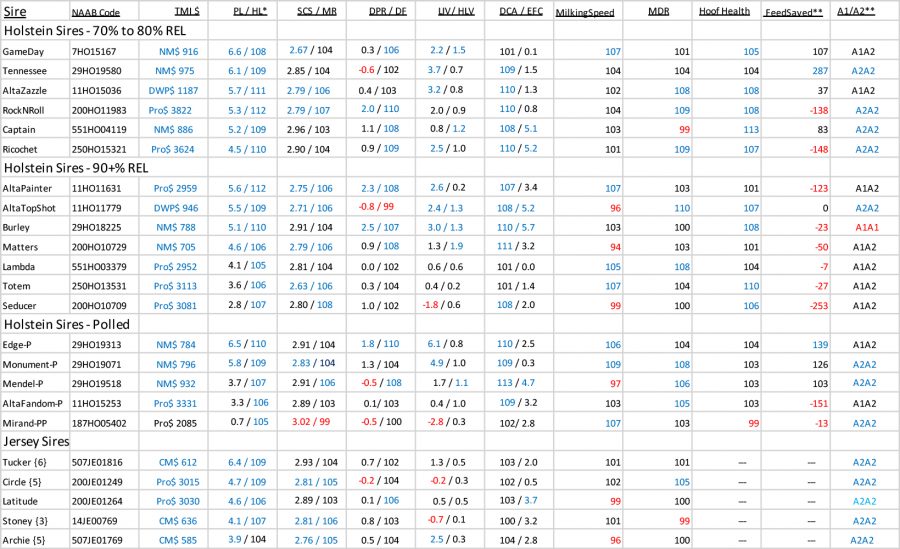
* Sires are listed in order of PL
** Feed Saved and A1/A2 are included for information purposes.
Coding: Blue – improver; Black – average; & Red – below average.
Benefits of Selecting Sires and Culling Herds for Functional Traits
Dairy farmers in the Nordic Countries have been culling their herds and selecting sires for functional traits since 1978. The result has been improved fertility, less sickness, less disease, less lameness, lower herd turn-over and more profit.
After putting a focus on selecting for key functional traits for two generations (5-7 years), North American dairy farmers can achieve as reduction in expense per cow per year of $300. For a 500 cow herd that is $150,000 per year – a very worthwhile achievement. And, that can be done without spending more for semen.
The Bullvine Bottom Line.
Dairy farmers are continually fine tuning their farming and cattle breeding programs. Where once genetic selection was focused on production and conformation, genetic indexes are available or will increasingly become available to select for traits that support digging deeper into reducing the costs associated with feed required, reproduction, animal health and welfare, body functions and rearing herd replacements.
Planning for both animal and herd futures takes vision and goals. The Bullvine encourages all dairy cattle breeders to expand their use of genetic indexes. As sires account for over 90% of a herd’s genetic improvement, refining and focusing sire selection to include more economically important traits will be a wise business decision. May breeders have much success using the genetic indexes for functional traits.

Get original “Bullvine” content sent straight to your email inbox for free.









